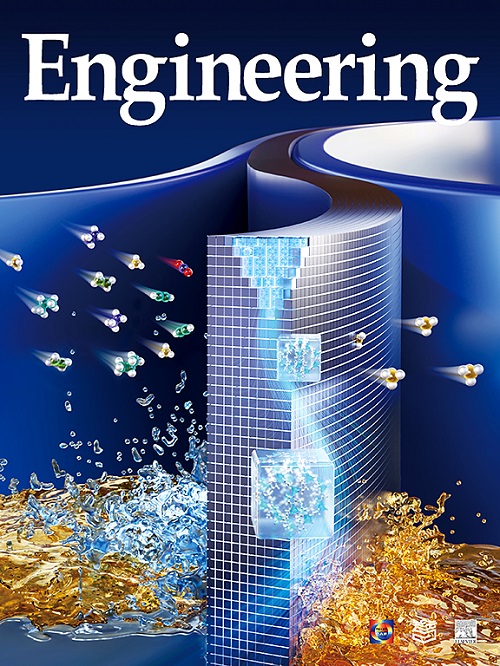以褐煤为燃料的5- mw化学循环燃烧装置的演示
IF 10.1
1区 工程技术
Q1 ENGINEERING, MULTIDISCIPLINARY
引用次数: 0
摘要
一个5兆瓦的化学循环燃烧(CLC)装置在中国设计、建造、运行和演示,作为中欧减排解决方案(CHEERS)项目的一部分,由中国科技部(MOST)和欧盟(EU)的地平线2020项目资助。在中国合作伙伴设计的配置中,空气反应器(AR)是一个输送床,而燃料反应器(FR)是一个鼓泡/湍流流化床。FR和AR之间的固体循环由溢流方式调节,AR旋风器中的载氧体(OC)返回FR立管。从2024年6月到9月,5 MWth示范机组或多或少地连续运行和测试,热输入范围为3.5至5.0 MWth。在运行过程中,所有固体燃料都被送入FR的致密床层,而只有空气被引入AR。没有施加电或其他外部加热,这意味着整个中试装置都是通过AR内OC的氧化来加热的。因此,成功地实现了自动加热CLC操作。机组加热在48小时内完成;此外,切换到CLC模式简单,只需不到1小时。在运行过程中,整个回路的温度是稳定的。AR和FR的温度分别为1000 ~ 1040℃和940 ~ 980℃。运行数据表明,以褐煤为原料的CLC装置最大CO2捕集效率大于97%,对FR未燃烧气体的最小需氧量为2.45%。这项工作在CLC领域的实验室规模研究和工业应用之间架起了桥梁。本文章由计算机程序翻译,如有差异,请以英文原文为准。
Demonstration of a 5-MWth Chemical Looping Combustion Unit Fueled by Lignite
A 5-MWth chemical looping combustion (CLC) unit was designed, built, operated, and demonstrated in China as part of the Chinese–European Emission-Reducing Solutions (CHEERS) project, funded by China’s Ministry of Science and Technology (MOST) and the European Union (EU)’s Horizon 2020. In the configuration designed by the Chinese partners, the air reactor (AR) is a transport bed, while the fuel reactor (FR) is a bubbling/turbulent fluidized bed. The solid circulation between the FR and AR is regulated by the overflow method, and the oxygen carrier (OC) from the AR cyclone returns to the FR riser. From June to September 2024, the 5-MWth demonstration unit was operated and tested more or less continuously, with a thermal input ranging from 3.5 to 5.0 MWth. During the operation, all solid fuel was fed into the dense bed of the FR, while only air was introduced into the AR. No electric or other external heating was applied, meaning that the whole pilot unit was heated by the oxidation of the OC within the AR. Hence, auto-thermal CLC operation was successfully achieved. Heating the unit was completed in 48 h; furthermore, switching to CLC mode was straightforward and took less than 1 h. During the operation, the temperature of the entire loop was stable. The temperatures of the AR and FR were 1000–1040 °C and 940–980 °C, respectively. Based on the operational data, the maximum CO2 capture efficiency of the lignite-fed CLC unit was greater than 97%, and the minimum oxygen demand for unburnt gases from the FR was 2.45%. This work bridges the gap between lab-scale research and industrial applications in the field of CLC.
求助全文
通过发布文献求助,成功后即可免费获取论文全文。
去求助
来源期刊

Engineering
Environmental Science-Environmental Engineering
自引率
1.60%
发文量
335
审稿时长
35 days
期刊介绍:
Engineering, an international open-access journal initiated by the Chinese Academy of Engineering (CAE) in 2015, serves as a distinguished platform for disseminating cutting-edge advancements in engineering R&D, sharing major research outputs, and highlighting key achievements worldwide. The journal's objectives encompass reporting progress in engineering science, fostering discussions on hot topics, addressing areas of interest, challenges, and prospects in engineering development, while considering human and environmental well-being and ethics in engineering. It aims to inspire breakthroughs and innovations with profound economic and social significance, propelling them to advanced international standards and transforming them into a new productive force. Ultimately, this endeavor seeks to bring about positive changes globally, benefit humanity, and shape a new future.
 求助内容:
求助内容: 应助结果提醒方式:
应助结果提醒方式:


